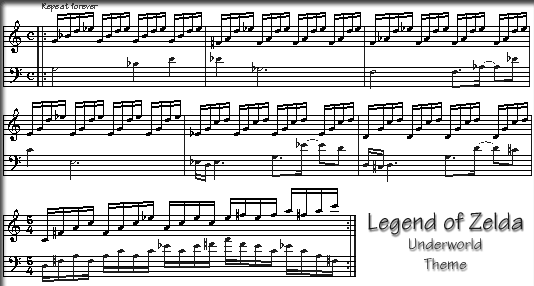
Following the video game crash in 1984, the Nintendo Entertainment System trickled into the US in 1985, and was the first major system to feature continuous soundtracks throughout its games. It's widely recognized as the console which elevated game music from simple beeps and whistles to an art form composed of beeps and whistles  .
.
The anthem from Nintendo's launch game, Super Mario Brothers, continued to appear in variations throughout the Mario series and even spawned lyrics when it became the theme song to the horrible television show based on the game. "Swing your arms from side to side. Come on, it's time to go. Do the Mario!..."  (MP3, 203KB)
(MP3, 203KB)
Early Nintendo games could play four separate tracks of sound or music simultaneously, and most developers devoted three full tracks to music (melody, bass line, faux percussion) with the fourth track reserved for sound effects. When more sounds were required, they were often provided at the expense of the music. In one memorable example, The Legend of Zelda played a constant beeping noise when the player was near death. Since the regular sound effects were still important, the developers played the beeping by temporarily covering what they considered to be the least important track of music with the beep track. If you still own a NES and this particular game, and are a musical geek, it's an interesting exercise to wander through the various parts of the game with very little health, to hear the incomplete versions of the soundtrack.
The vast majority of NES soundtracks were also continuous loops. Developers would write music that was a direct accompaniment to the level, and end in a way that would seamlessly allow a jump back to the beginning. The Legend of Zelda had a blatantly brief example: its underworld theme, which played in eight dungeons throughout the game, was just seven bars long. Gamers today tend to have a great sense of nostalgia for memorable tunes of the NES. This probably has more to do with the constant repetition of music during those long hours spent playing games, rather than any musical genius.
On the PC side, music was still a mono-track affair. The PC's internal speaker was capable of playing one beep at a time, at a variety of pitch levels. Rather than focus on music, this ability was spent on sound effects more often than not. By varying pitch levels and repeating extremely short beeps, you could almost create a sound that was close to recognizable. Today's new gamers would undoubtedly hear nothing but bursts of flatulence at a series of pitch levels in those archaic sounds.
In the late 80s, this manipulation of the internal speaker was actually accessible through the BASIC computer language (in which I wrote several childish, incomplete games). Writing music consisted of entering a series of pitches, octaves, and durations, much like using the Command Line plug-in in Finale. For example, the beginning of Three Blind Mice would be notated as "L4edL2c L4edL2c L4gL8ffL2e L4gL8ffL2e". Though I didn't know much about composing or notation at the time, I remember decorating my little BASIC games with short original melodies for each "room". The medium was very limiting, but I do recall hearing someone's realization of the complete William Tell overture, which was quite incredible when you consider that every chord had to be rolled.
Tomorrow: Later NES Music and the Advent of Soundcards
|
tagged as
music,
games
|
permalink
| 0 comments
|
|
|
Previous Post: Untitled Post |
Next Post: Untitled Post |
You are currently viewing a single post from the annals of URI! Zone history. The entire URI! Zone is © 1996 - 2024 by Brian Uri!. Please see the About page for further information.
